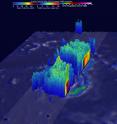NASA's GPM spots Tropical Cyclone Emeraude developing
Tropical Cyclone Emeraude developed early on March 16 in the Southern Indian Ocean, but NASA's GPM core satellite saw the storm coming together the day before. The Global Precipitation Measurement or GPM Core Observatory satellite saw tropical cyclone Emeraude forming in the South Indian ocean on March 15, 2016 at 0900 UTC (5 a.m. EDT). A rainfall analysis using data collected by GPM's Microwave Imager (GMI) and Dual-Frequency Precipitation Radar (DPR) showed rain bands wrapping around a tropical low pressure area. GPM's DPR measured rain falling at the extreme rate of over 220 mm (8.7 inches) per hour in powerful storms south of the low's center of circulation.
GPM's radar (DPR Ku Band) data were able to show the 3-D structure of precipitation within the tropical low. GPM radar measured storm tops heights above 15 km (9.3 miles) high. Intense showers were returning radar reflectivity values greater than 52 dbZ to the satellite. The GPM mission is co-managed by NASA and the Japan Aerospace Exploration Agency.
On March 16 at 0900 UTC (5 a.m. EDT), Tropical Cyclone Emeraude was located near 10.8 degrees south latitude and 84.9 degrees east longitude. That's about 768 nautical miles (883.8 miles/1,422 km) east-southeast of Diego Garcia. It was moving to the west-northwest at 5 knots (5.7 mph/9.2 kph). Maximum sustained winds were near 55 knots (63.2 mph/101.9 kph) and it was strengthening.
The Joint Typhoon Warning Center (JTWC) expects Emeraude to turn to the east-southeast, intensifying to 105 knots by March 18 as it moves through an area of warm sea surface temperatures and low vertical wind shear. Emeraude is then expected to turn south and weaken.
Source: NASA/Goddard Space Flight Center
Articles on the same topic
- NASA sees heavy rain in Tropical Cyclone EmeraudeFri, 18 Mar 2016, 16:06:10 UTC
- NASA examines powerful Tropical Cyclone Emeraude's winds, cloudsThu, 17 Mar 2016, 18:04:05 UTC
- NASA's Aqua Satellite sees Tropical Cyclone 16P form in Gulf of CarpentariaThu, 17 Mar 2016, 18:03:48 UTC
Other sources
- NASA sees heavy rain in Tropical Cyclone Emeraudefrom PhysorgFri, 18 Mar 2016, 16:10:34 UTC
- NASA examines powerful Tropical Cyclone Emeraude's winds, cloudsfrom PhysorgThu, 17 Mar 2016, 18:01:02 UTC
- GPM spots Tropical Cyclone Emeraude developingfrom PhysorgWed, 16 Mar 2016, 16:51:24 UTC
- Aqua Satellite sees Tropical Cyclone 16P form in Gulf of Carpentariafrom PhysorgWed, 16 Mar 2016, 16:20:52 UTC
